Analyzing HRM Issues: Flat Metal Pressing Company Case Study Report
VerifiedAdded on 2020/03/03
|14
|3490
|21
Case Study
AI Summary
This case study examines the HRM practices of the Flat Metal Pressing Company, a long-standing manufacturer facing challenges due to aging workforce and financial instability. The assignment analyzes the company's current HRM functions, highlighting the lack of strategic HR planning, training and development programs, and effective change management strategies. It explores the importance of HR planning, training, and change management for organizational success, emphasizing the need for employee development and legislative compliance. The study also applies Kotter's change model to propose improvements, focusing on addressing the company's internal and external environment. Finally, it considers the relevance of employment legislation, particularly anti-discrimination laws, to ensure fair and compliant HR practices. This comprehensive analysis aims to provide insights into the company's HRM challenges and suggest potential solutions for improvement.
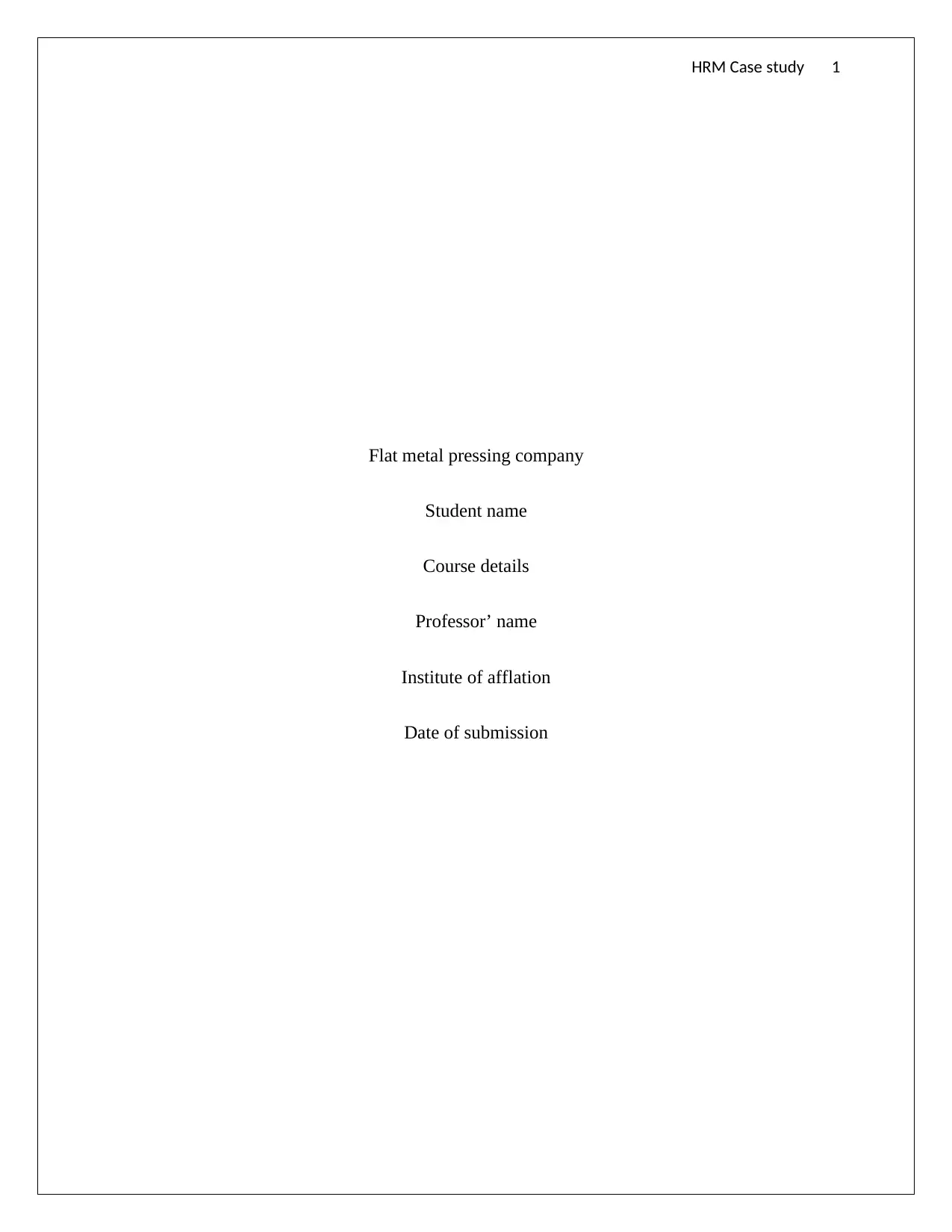
HRM Case study 1
Flat metal pressing company
Student name
Course details
Professor’ name
Institute of afflation
Date of submission
Flat metal pressing company
Student name
Course details
Professor’ name
Institute of afflation
Date of submission
Paraphrase This Document
Need a fresh take? Get an instant paraphrase of this document with our AI Paraphraser
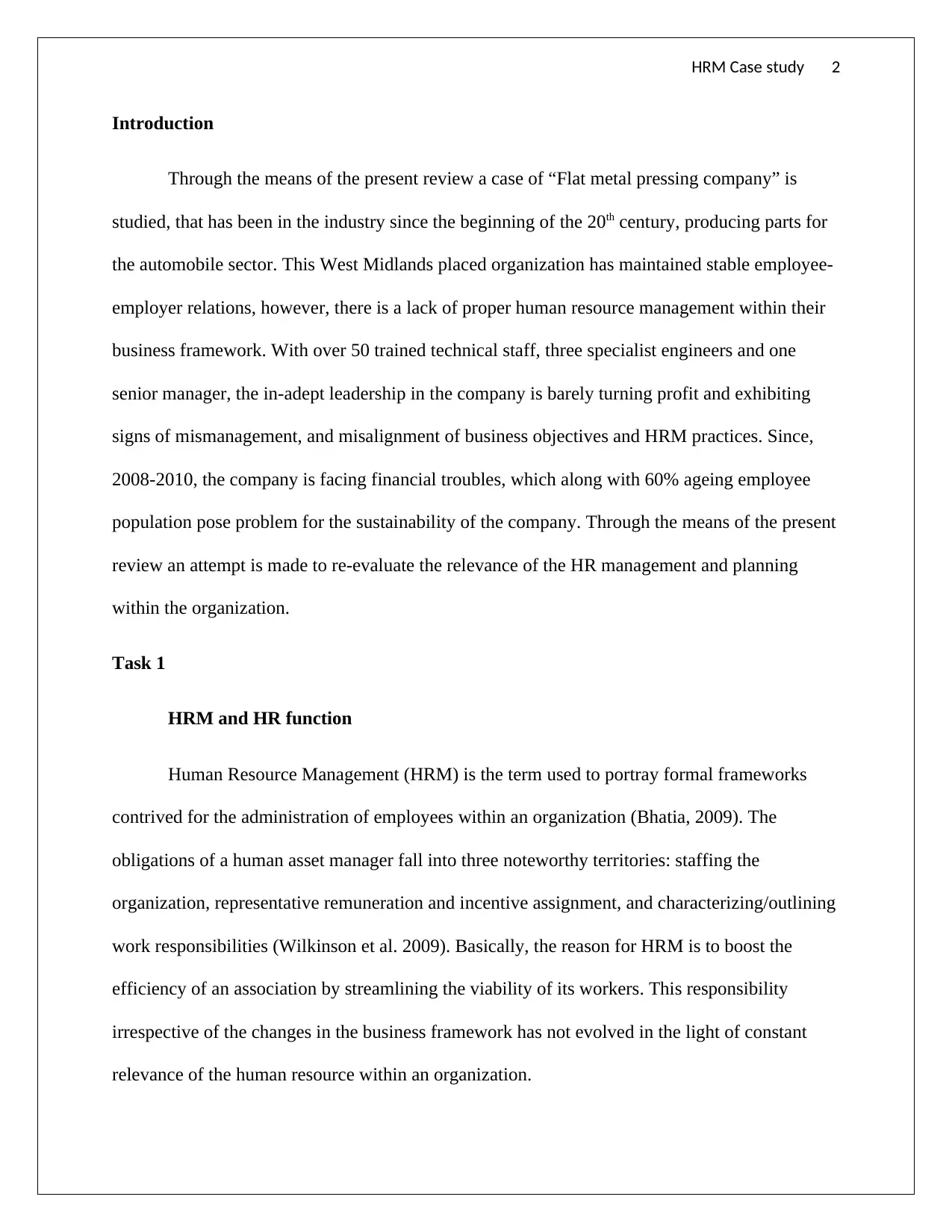
HRM Case study 2
Introduction
Through the means of the present review a case of “Flat metal pressing company” is
studied, that has been in the industry since the beginning of the 20th century, producing parts for
the automobile sector. This West Midlands placed organization has maintained stable employee-
employer relations, however, there is a lack of proper human resource management within their
business framework. With over 50 trained technical staff, three specialist engineers and one
senior manager, the in-adept leadership in the company is barely turning profit and exhibiting
signs of mismanagement, and misalignment of business objectives and HRM practices. Since,
2008-2010, the company is facing financial troubles, which along with 60% ageing employee
population pose problem for the sustainability of the company. Through the means of the present
review an attempt is made to re-evaluate the relevance of the HR management and planning
within the organization.
Task 1
HRM and HR function
Human Resource Management (HRM) is the term used to portray formal frameworks
contrived for the administration of employees within an organization (Bhatia, 2009). The
obligations of a human asset manager fall into three noteworthy territories: staffing the
organization, representative remuneration and incentive assignment, and characterizing/outlining
work responsibilities (Wilkinson et al. 2009). Basically, the reason for HRM is to boost the
efficiency of an association by streamlining the viability of its workers. This responsibility
irrespective of the changes in the business framework has not evolved in the light of constant
relevance of the human resource within an organization.
Introduction
Through the means of the present review a case of “Flat metal pressing company” is
studied, that has been in the industry since the beginning of the 20th century, producing parts for
the automobile sector. This West Midlands placed organization has maintained stable employee-
employer relations, however, there is a lack of proper human resource management within their
business framework. With over 50 trained technical staff, three specialist engineers and one
senior manager, the in-adept leadership in the company is barely turning profit and exhibiting
signs of mismanagement, and misalignment of business objectives and HRM practices. Since,
2008-2010, the company is facing financial troubles, which along with 60% ageing employee
population pose problem for the sustainability of the company. Through the means of the present
review an attempt is made to re-evaluate the relevance of the HR management and planning
within the organization.
Task 1
HRM and HR function
Human Resource Management (HRM) is the term used to portray formal frameworks
contrived for the administration of employees within an organization (Bhatia, 2009). The
obligations of a human asset manager fall into three noteworthy territories: staffing the
organization, representative remuneration and incentive assignment, and characterizing/outlining
work responsibilities (Wilkinson et al. 2009). Basically, the reason for HRM is to boost the
efficiency of an association by streamlining the viability of its workers. This responsibility
irrespective of the changes in the business framework has not evolved in the light of constant
relevance of the human resource within an organization.
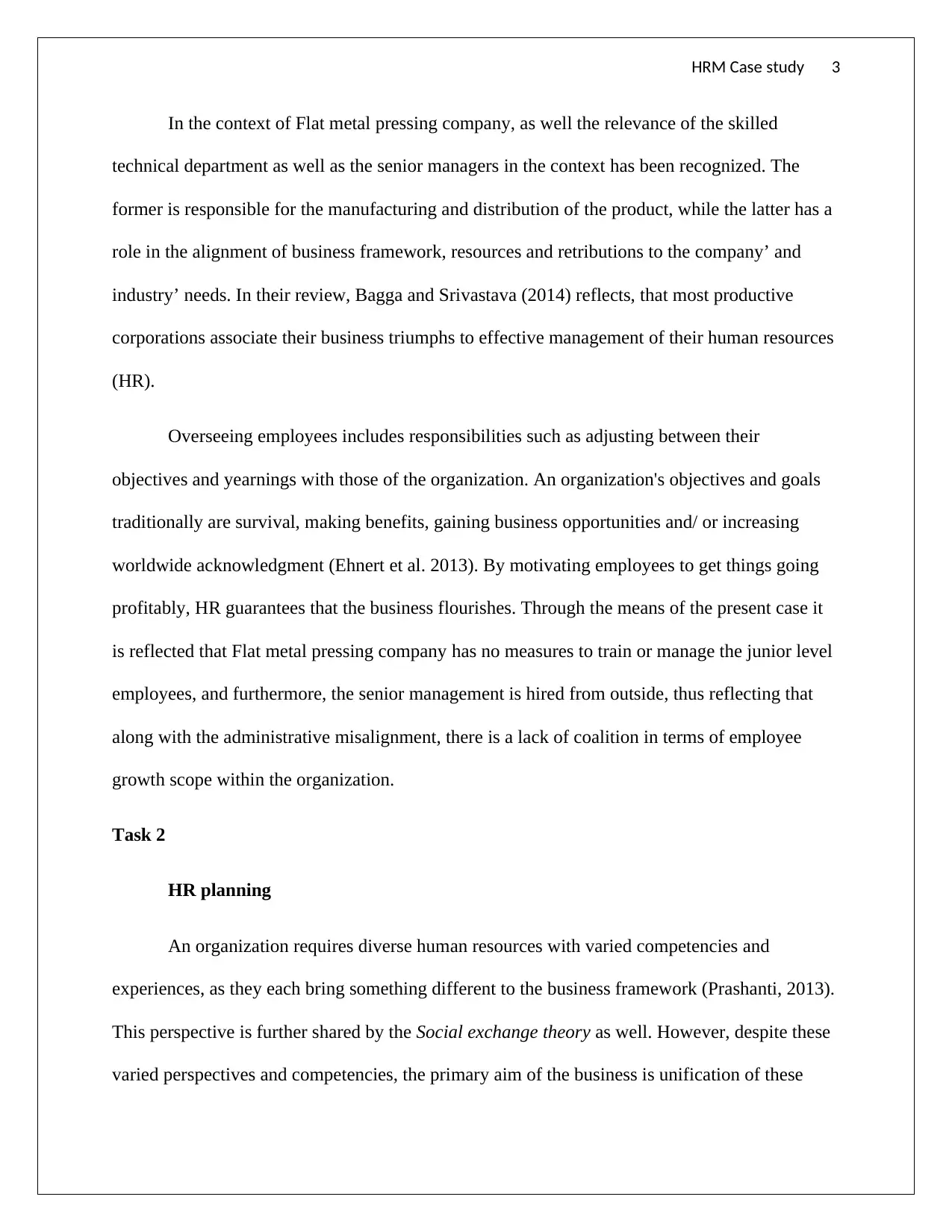
HRM Case study 3
In the context of Flat metal pressing company, as well the relevance of the skilled
technical department as well as the senior managers in the context has been recognized. The
former is responsible for the manufacturing and distribution of the product, while the latter has a
role in the alignment of business framework, resources and retributions to the company’ and
industry’ needs. In their review, Bagga and Srivastava (2014) reflects, that most productive
corporations associate their business triumphs to effective management of their human resources
(HR).
Overseeing employees includes responsibilities such as adjusting between their
objectives and yearnings with those of the organization. An organization's objectives and goals
traditionally are survival, making benefits, gaining business opportunities and/ or increasing
worldwide acknowledgment (Ehnert et al. 2013). By motivating employees to get things going
profitably, HR guarantees that the business flourishes. Through the means of the present case it
is reflected that Flat metal pressing company has no measures to train or manage the junior level
employees, and furthermore, the senior management is hired from outside, thus reflecting that
along with the administrative misalignment, there is a lack of coalition in terms of employee
growth scope within the organization.
Task 2
HR planning
An organization requires diverse human resources with varied competencies and
experiences, as they each bring something different to the business framework (Prashanti, 2013).
This perspective is further shared by the Social exchange theory as well. However, despite these
varied perspectives and competencies, the primary aim of the business is unification of these
In the context of Flat metal pressing company, as well the relevance of the skilled
technical department as well as the senior managers in the context has been recognized. The
former is responsible for the manufacturing and distribution of the product, while the latter has a
role in the alignment of business framework, resources and retributions to the company’ and
industry’ needs. In their review, Bagga and Srivastava (2014) reflects, that most productive
corporations associate their business triumphs to effective management of their human resources
(HR).
Overseeing employees includes responsibilities such as adjusting between their
objectives and yearnings with those of the organization. An organization's objectives and goals
traditionally are survival, making benefits, gaining business opportunities and/ or increasing
worldwide acknowledgment (Ehnert et al. 2013). By motivating employees to get things going
profitably, HR guarantees that the business flourishes. Through the means of the present case it
is reflected that Flat metal pressing company has no measures to train or manage the junior level
employees, and furthermore, the senior management is hired from outside, thus reflecting that
along with the administrative misalignment, there is a lack of coalition in terms of employee
growth scope within the organization.
Task 2
HR planning
An organization requires diverse human resources with varied competencies and
experiences, as they each bring something different to the business framework (Prashanti, 2013).
This perspective is further shared by the Social exchange theory as well. However, despite these
varied perspectives and competencies, the primary aim of the business is unification of these
⊘ This is a preview!⊘
Do you want full access?
Subscribe today to unlock all pages.

Trusted by 1+ million students worldwide
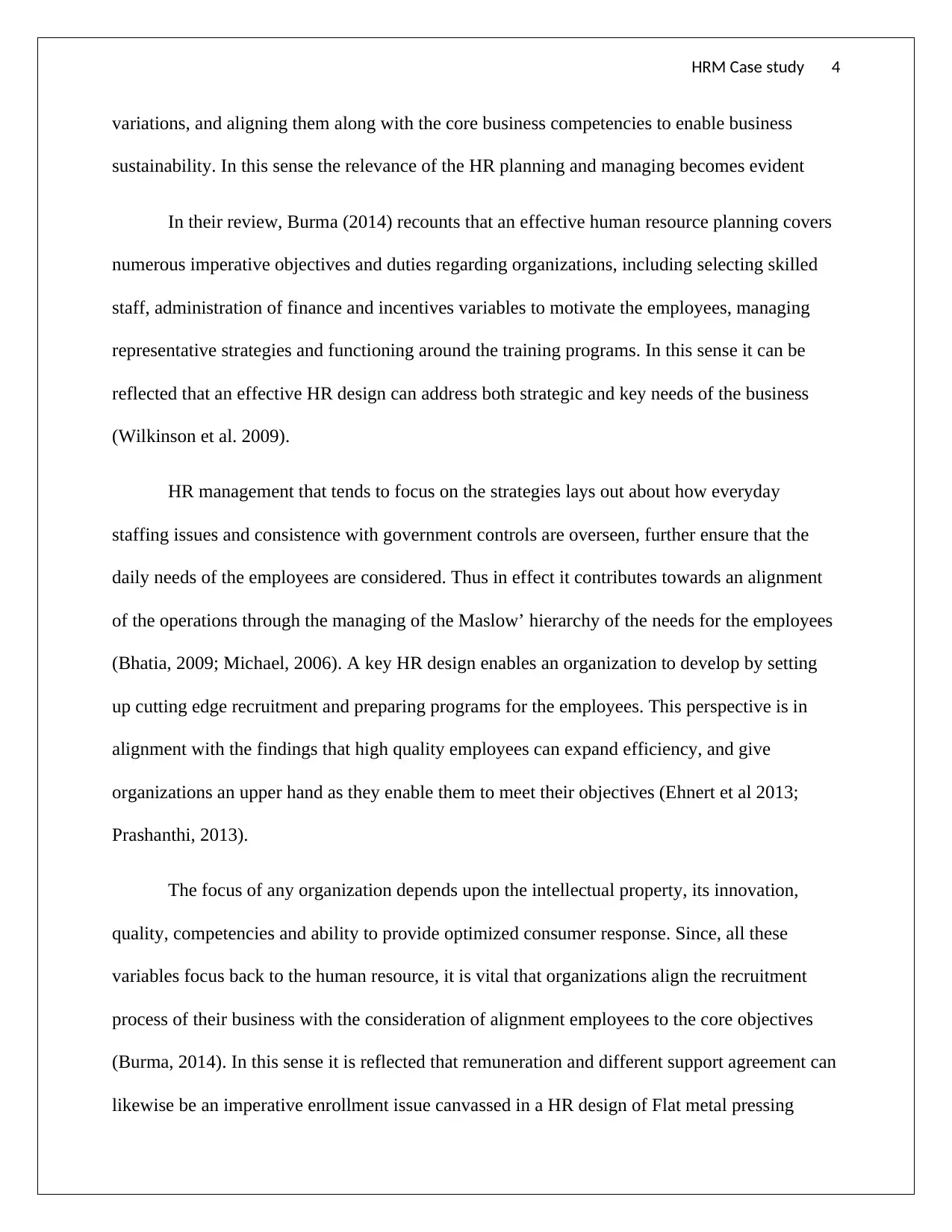
HRM Case study 4
variations, and aligning them along with the core business competencies to enable business
sustainability. In this sense the relevance of the HR planning and managing becomes evident
In their review, Burma (2014) recounts that an effective human resource planning covers
numerous imperative objectives and duties regarding organizations, including selecting skilled
staff, administration of finance and incentives variables to motivate the employees, managing
representative strategies and functioning around the training programs. In this sense it can be
reflected that an effective HR design can address both strategic and key needs of the business
(Wilkinson et al. 2009).
HR management that tends to focus on the strategies lays out about how everyday
staffing issues and consistence with government controls are overseen, further ensure that the
daily needs of the employees are considered. Thus in effect it contributes towards an alignment
of the operations through the managing of the Maslow’ hierarchy of the needs for the employees
(Bhatia, 2009; Michael, 2006). A key HR design enables an organization to develop by setting
up cutting edge recruitment and preparing programs for the employees. This perspective is in
alignment with the findings that high quality employees can expand efficiency, and give
organizations an upper hand as they enable them to meet their objectives (Ehnert et al 2013;
Prashanthi, 2013).
The focus of any organization depends upon the intellectual property, its innovation,
quality, competencies and ability to provide optimized consumer response. Since, all these
variables focus back to the human resource, it is vital that organizations align the recruitment
process of their business with the consideration of alignment employees to the core objectives
(Burma, 2014). In this sense it is reflected that remuneration and different support agreement can
likewise be an imperative enrollment issue canvassed in a HR design of Flat metal pressing
variations, and aligning them along with the core business competencies to enable business
sustainability. In this sense the relevance of the HR planning and managing becomes evident
In their review, Burma (2014) recounts that an effective human resource planning covers
numerous imperative objectives and duties regarding organizations, including selecting skilled
staff, administration of finance and incentives variables to motivate the employees, managing
representative strategies and functioning around the training programs. In this sense it can be
reflected that an effective HR design can address both strategic and key needs of the business
(Wilkinson et al. 2009).
HR management that tends to focus on the strategies lays out about how everyday
staffing issues and consistence with government controls are overseen, further ensure that the
daily needs of the employees are considered. Thus in effect it contributes towards an alignment
of the operations through the managing of the Maslow’ hierarchy of the needs for the employees
(Bhatia, 2009; Michael, 2006). A key HR design enables an organization to develop by setting
up cutting edge recruitment and preparing programs for the employees. This perspective is in
alignment with the findings that high quality employees can expand efficiency, and give
organizations an upper hand as they enable them to meet their objectives (Ehnert et al 2013;
Prashanthi, 2013).
The focus of any organization depends upon the intellectual property, its innovation,
quality, competencies and ability to provide optimized consumer response. Since, all these
variables focus back to the human resource, it is vital that organizations align the recruitment
process of their business with the consideration of alignment employees to the core objectives
(Burma, 2014). In this sense it is reflected that remuneration and different support agreement can
likewise be an imperative enrollment issue canvassed in a HR design of Flat metal pressing
Paraphrase This Document
Need a fresh take? Get an instant paraphrase of this document with our AI Paraphraser
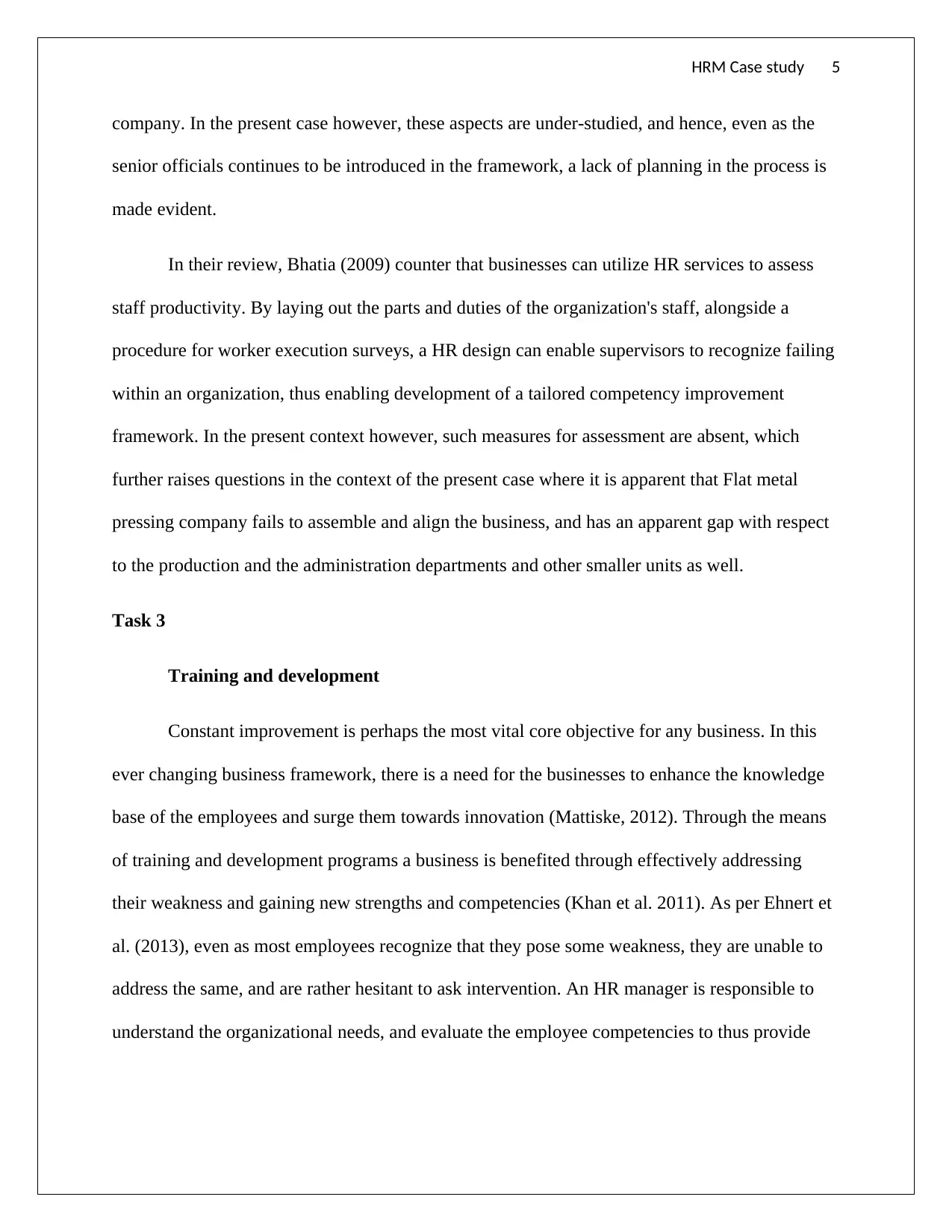
HRM Case study 5
company. In the present case however, these aspects are under-studied, and hence, even as the
senior officials continues to be introduced in the framework, a lack of planning in the process is
made evident.
In their review, Bhatia (2009) counter that businesses can utilize HR services to assess
staff productivity. By laying out the parts and duties of the organization's staff, alongside a
procedure for worker execution surveys, a HR design can enable supervisors to recognize failing
within an organization, thus enabling development of a tailored competency improvement
framework. In the present context however, such measures for assessment are absent, which
further raises questions in the context of the present case where it is apparent that Flat metal
pressing company fails to assemble and align the business, and has an apparent gap with respect
to the production and the administration departments and other smaller units as well.
Task 3
Training and development
Constant improvement is perhaps the most vital core objective for any business. In this
ever changing business framework, there is a need for the businesses to enhance the knowledge
base of the employees and surge them towards innovation (Mattiske, 2012). Through the means
of training and development programs a business is benefited through effectively addressing
their weakness and gaining new strengths and competencies (Khan et al. 2011). As per Ehnert et
al. (2013), even as most employees recognize that they pose some weakness, they are unable to
address the same, and are rather hesitant to ask intervention. An HR manager is responsible to
understand the organizational needs, and evaluate the employee competencies to thus provide
company. In the present case however, these aspects are under-studied, and hence, even as the
senior officials continues to be introduced in the framework, a lack of planning in the process is
made evident.
In their review, Bhatia (2009) counter that businesses can utilize HR services to assess
staff productivity. By laying out the parts and duties of the organization's staff, alongside a
procedure for worker execution surveys, a HR design can enable supervisors to recognize failing
within an organization, thus enabling development of a tailored competency improvement
framework. In the present context however, such measures for assessment are absent, which
further raises questions in the context of the present case where it is apparent that Flat metal
pressing company fails to assemble and align the business, and has an apparent gap with respect
to the production and the administration departments and other smaller units as well.
Task 3
Training and development
Constant improvement is perhaps the most vital core objective for any business. In this
ever changing business framework, there is a need for the businesses to enhance the knowledge
base of the employees and surge them towards innovation (Mattiske, 2012). Through the means
of training and development programs a business is benefited through effectively addressing
their weakness and gaining new strengths and competencies (Khan et al. 2011). As per Ehnert et
al. (2013), even as most employees recognize that they pose some weakness, they are unable to
address the same, and are rather hesitant to ask intervention. An HR manager is responsible to
understand the organizational needs, and evaluate the employee competencies to thus provide
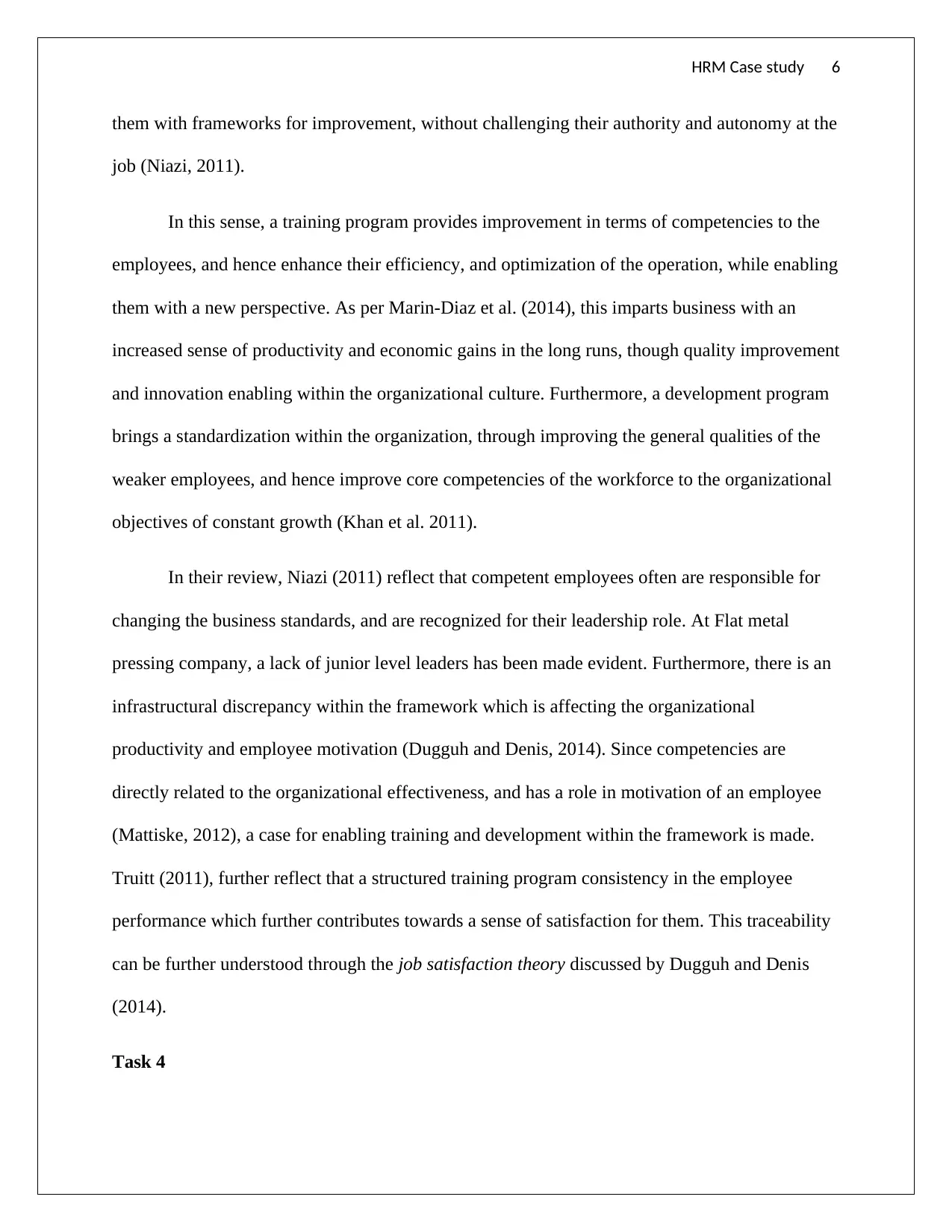
HRM Case study 6
them with frameworks for improvement, without challenging their authority and autonomy at the
job (Niazi, 2011).
In this sense, a training program provides improvement in terms of competencies to the
employees, and hence enhance their efficiency, and optimization of the operation, while enabling
them with a new perspective. As per Marin-Diaz et al. (2014), this imparts business with an
increased sense of productivity and economic gains in the long runs, though quality improvement
and innovation enabling within the organizational culture. Furthermore, a development program
brings a standardization within the organization, through improving the general qualities of the
weaker employees, and hence improve core competencies of the workforce to the organizational
objectives of constant growth (Khan et al. 2011).
In their review, Niazi (2011) reflect that competent employees often are responsible for
changing the business standards, and are recognized for their leadership role. At Flat metal
pressing company, a lack of junior level leaders has been made evident. Furthermore, there is an
infrastructural discrepancy within the framework which is affecting the organizational
productivity and employee motivation (Dugguh and Denis, 2014). Since competencies are
directly related to the organizational effectiveness, and has a role in motivation of an employee
(Mattiske, 2012), a case for enabling training and development within the framework is made.
Truitt (2011), further reflect that a structured training program consistency in the employee
performance which further contributes towards a sense of satisfaction for them. This traceability
can be further understood through the job satisfaction theory discussed by Dugguh and Denis
(2014).
Task 4
them with frameworks for improvement, without challenging their authority and autonomy at the
job (Niazi, 2011).
In this sense, a training program provides improvement in terms of competencies to the
employees, and hence enhance their efficiency, and optimization of the operation, while enabling
them with a new perspective. As per Marin-Diaz et al. (2014), this imparts business with an
increased sense of productivity and economic gains in the long runs, though quality improvement
and innovation enabling within the organizational culture. Furthermore, a development program
brings a standardization within the organization, through improving the general qualities of the
weaker employees, and hence improve core competencies of the workforce to the organizational
objectives of constant growth (Khan et al. 2011).
In their review, Niazi (2011) reflect that competent employees often are responsible for
changing the business standards, and are recognized for their leadership role. At Flat metal
pressing company, a lack of junior level leaders has been made evident. Furthermore, there is an
infrastructural discrepancy within the framework which is affecting the organizational
productivity and employee motivation (Dugguh and Denis, 2014). Since competencies are
directly related to the organizational effectiveness, and has a role in motivation of an employee
(Mattiske, 2012), a case for enabling training and development within the framework is made.
Truitt (2011), further reflect that a structured training program consistency in the employee
performance which further contributes towards a sense of satisfaction for them. This traceability
can be further understood through the job satisfaction theory discussed by Dugguh and Denis
(2014).
Task 4
⊘ This is a preview!⊘
Do you want full access?
Subscribe today to unlock all pages.

Trusted by 1+ million students worldwide
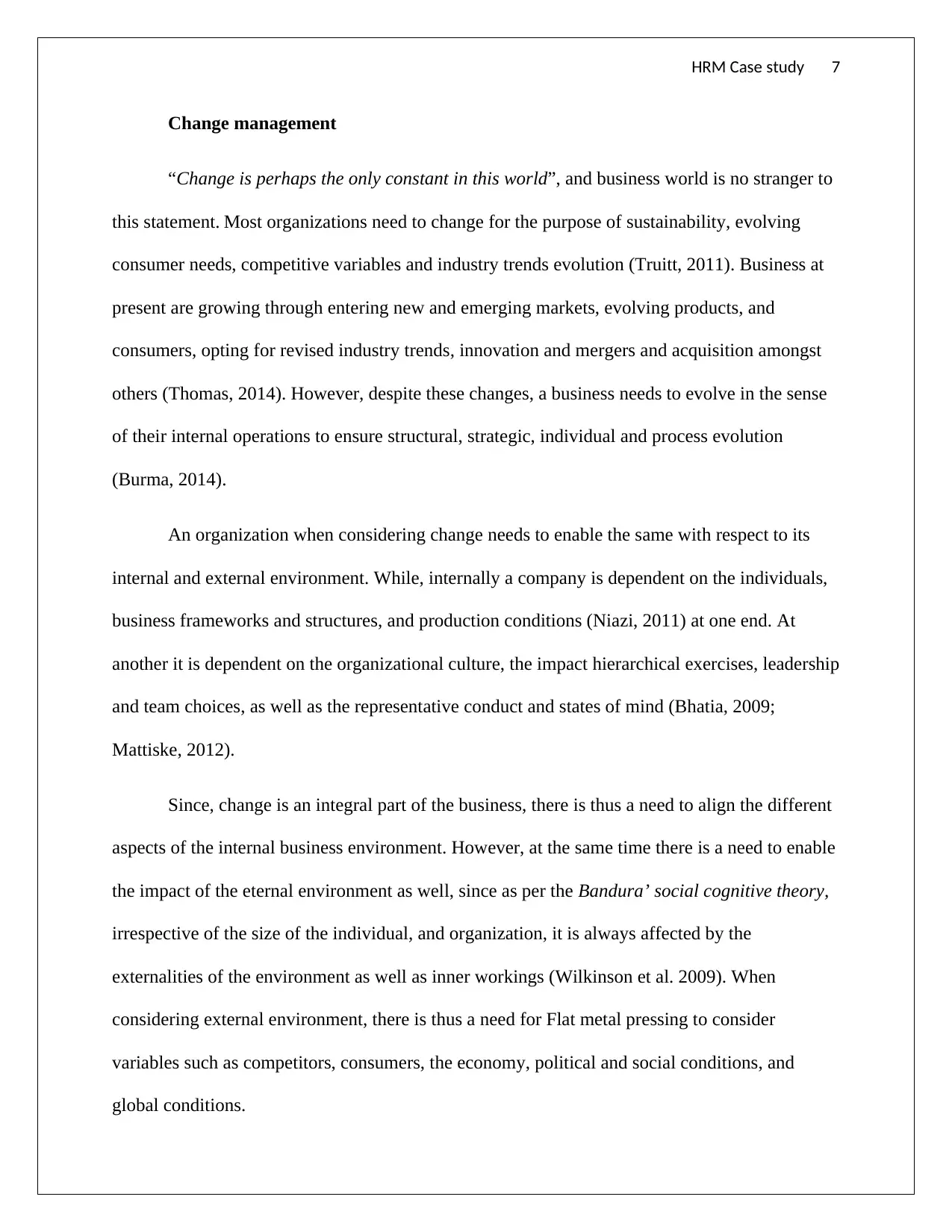
HRM Case study 7
Change management
“Change is perhaps the only constant in this world”, and business world is no stranger to
this statement. Most organizations need to change for the purpose of sustainability, evolving
consumer needs, competitive variables and industry trends evolution (Truitt, 2011). Business at
present are growing through entering new and emerging markets, evolving products, and
consumers, opting for revised industry trends, innovation and mergers and acquisition amongst
others (Thomas, 2014). However, despite these changes, a business needs to evolve in the sense
of their internal operations to ensure structural, strategic, individual and process evolution
(Burma, 2014).
An organization when considering change needs to enable the same with respect to its
internal and external environment. While, internally a company is dependent on the individuals,
business frameworks and structures, and production conditions (Niazi, 2011) at one end. At
another it is dependent on the organizational culture, the impact hierarchical exercises, leadership
and team choices, as well as the representative conduct and states of mind (Bhatia, 2009;
Mattiske, 2012).
Since, change is an integral part of the business, there is thus a need to align the different
aspects of the internal business environment. However, at the same time there is a need to enable
the impact of the eternal environment as well, since as per the Bandura’ social cognitive theory,
irrespective of the size of the individual, and organization, it is always affected by the
externalities of the environment as well as inner workings (Wilkinson et al. 2009). When
considering external environment, there is thus a need for Flat metal pressing to consider
variables such as competitors, consumers, the economy, political and social conditions, and
global conditions.
Change management
“Change is perhaps the only constant in this world”, and business world is no stranger to
this statement. Most organizations need to change for the purpose of sustainability, evolving
consumer needs, competitive variables and industry trends evolution (Truitt, 2011). Business at
present are growing through entering new and emerging markets, evolving products, and
consumers, opting for revised industry trends, innovation and mergers and acquisition amongst
others (Thomas, 2014). However, despite these changes, a business needs to evolve in the sense
of their internal operations to ensure structural, strategic, individual and process evolution
(Burma, 2014).
An organization when considering change needs to enable the same with respect to its
internal and external environment. While, internally a company is dependent on the individuals,
business frameworks and structures, and production conditions (Niazi, 2011) at one end. At
another it is dependent on the organizational culture, the impact hierarchical exercises, leadership
and team choices, as well as the representative conduct and states of mind (Bhatia, 2009;
Mattiske, 2012).
Since, change is an integral part of the business, there is thus a need to align the different
aspects of the internal business environment. However, at the same time there is a need to enable
the impact of the eternal environment as well, since as per the Bandura’ social cognitive theory,
irrespective of the size of the individual, and organization, it is always affected by the
externalities of the environment as well as inner workings (Wilkinson et al. 2009). When
considering external environment, there is thus a need for Flat metal pressing to consider
variables such as competitors, consumers, the economy, political and social conditions, and
global conditions.
Paraphrase This Document
Need a fresh take? Get an instant paraphrase of this document with our AI Paraphraser
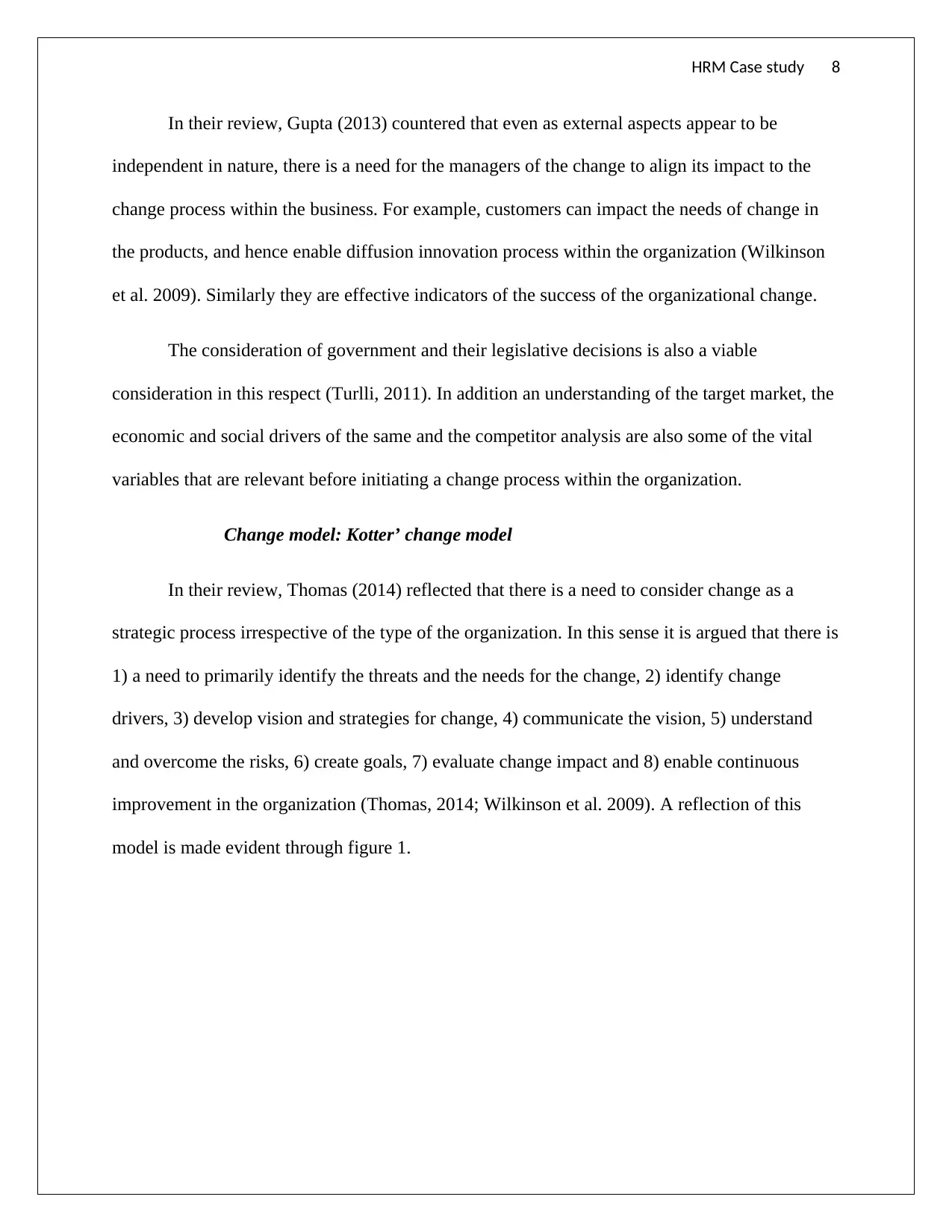
HRM Case study 8
In their review, Gupta (2013) countered that even as external aspects appear to be
independent in nature, there is a need for the managers of the change to align its impact to the
change process within the business. For example, customers can impact the needs of change in
the products, and hence enable diffusion innovation process within the organization (Wilkinson
et al. 2009). Similarly they are effective indicators of the success of the organizational change.
The consideration of government and their legislative decisions is also a viable
consideration in this respect (Turlli, 2011). In addition an understanding of the target market, the
economic and social drivers of the same and the competitor analysis are also some of the vital
variables that are relevant before initiating a change process within the organization.
Change model: Kotter’ change model
In their review, Thomas (2014) reflected that there is a need to consider change as a
strategic process irrespective of the type of the organization. In this sense it is argued that there is
1) a need to primarily identify the threats and the needs for the change, 2) identify change
drivers, 3) develop vision and strategies for change, 4) communicate the vision, 5) understand
and overcome the risks, 6) create goals, 7) evaluate change impact and 8) enable continuous
improvement in the organization (Thomas, 2014; Wilkinson et al. 2009). A reflection of this
model is made evident through figure 1.
In their review, Gupta (2013) countered that even as external aspects appear to be
independent in nature, there is a need for the managers of the change to align its impact to the
change process within the business. For example, customers can impact the needs of change in
the products, and hence enable diffusion innovation process within the organization (Wilkinson
et al. 2009). Similarly they are effective indicators of the success of the organizational change.
The consideration of government and their legislative decisions is also a viable
consideration in this respect (Turlli, 2011). In addition an understanding of the target market, the
economic and social drivers of the same and the competitor analysis are also some of the vital
variables that are relevant before initiating a change process within the organization.
Change model: Kotter’ change model
In their review, Thomas (2014) reflected that there is a need to consider change as a
strategic process irrespective of the type of the organization. In this sense it is argued that there is
1) a need to primarily identify the threats and the needs for the change, 2) identify change
drivers, 3) develop vision and strategies for change, 4) communicate the vision, 5) understand
and overcome the risks, 6) create goals, 7) evaluate change impact and 8) enable continuous
improvement in the organization (Thomas, 2014; Wilkinson et al. 2009). A reflection of this
model is made evident through figure 1.
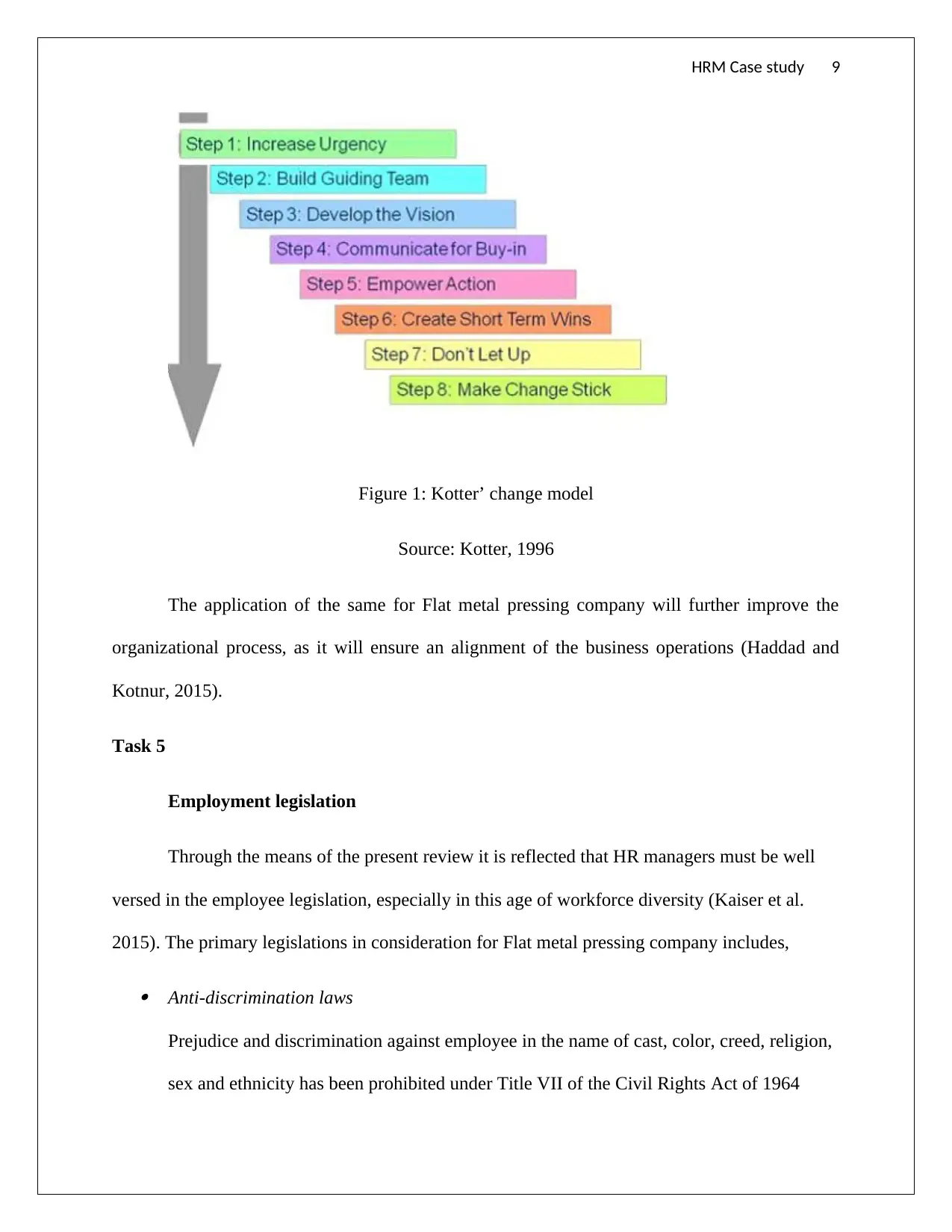
HRM Case study 9
Figure 1: Kotter’ change model
Source: Kotter, 1996
The application of the same for Flat metal pressing company will further improve the
organizational process, as it will ensure an alignment of the business operations (Haddad and
Kotnur, 2015).
Task 5
Employment legislation
Through the means of the present review it is reflected that HR managers must be well
versed in the employee legislation, especially in this age of workforce diversity (Kaiser et al.
2015). The primary legislations in consideration for Flat metal pressing company includes,
Anti-discrimination laws
Prejudice and discrimination against employee in the name of cast, color, creed, religion,
sex and ethnicity has been prohibited under Title VII of the Civil Rights Act of 1964
Figure 1: Kotter’ change model
Source: Kotter, 1996
The application of the same for Flat metal pressing company will further improve the
organizational process, as it will ensure an alignment of the business operations (Haddad and
Kotnur, 2015).
Task 5
Employment legislation
Through the means of the present review it is reflected that HR managers must be well
versed in the employee legislation, especially in this age of workforce diversity (Kaiser et al.
2015). The primary legislations in consideration for Flat metal pressing company includes,
Anti-discrimination laws
Prejudice and discrimination against employee in the name of cast, color, creed, religion,
sex and ethnicity has been prohibited under Title VII of the Civil Rights Act of 1964
⊘ This is a preview!⊘
Do you want full access?
Subscribe today to unlock all pages.

Trusted by 1+ million students worldwide
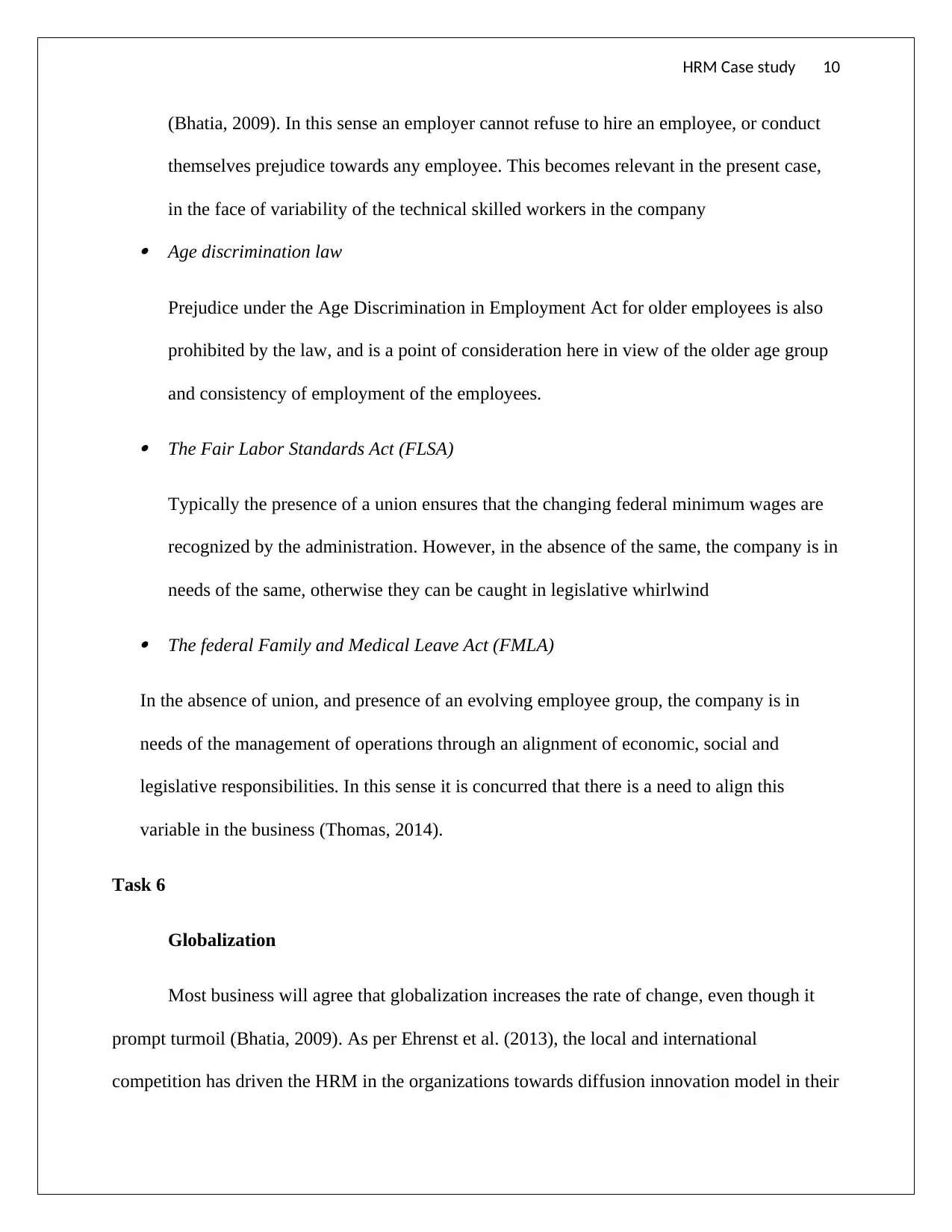
HRM Case study 10
(Bhatia, 2009). In this sense an employer cannot refuse to hire an employee, or conduct
themselves prejudice towards any employee. This becomes relevant in the present case,
in the face of variability of the technical skilled workers in the company Age discrimination law
Prejudice under the Age Discrimination in Employment Act for older employees is also
prohibited by the law, and is a point of consideration here in view of the older age group
and consistency of employment of the employees.
The Fair Labor Standards Act (FLSA)
Typically the presence of a union ensures that the changing federal minimum wages are
recognized by the administration. However, in the absence of the same, the company is in
needs of the same, otherwise they can be caught in legislative whirlwind
The federal Family and Medical Leave Act (FMLA)
In the absence of union, and presence of an evolving employee group, the company is in
needs of the management of operations through an alignment of economic, social and
legislative responsibilities. In this sense it is concurred that there is a need to align this
variable in the business (Thomas, 2014).
Task 6
Globalization
Most business will agree that globalization increases the rate of change, even though it
prompt turmoil (Bhatia, 2009). As per Ehrenst et al. (2013), the local and international
competition has driven the HRM in the organizations towards diffusion innovation model in their
(Bhatia, 2009). In this sense an employer cannot refuse to hire an employee, or conduct
themselves prejudice towards any employee. This becomes relevant in the present case,
in the face of variability of the technical skilled workers in the company Age discrimination law
Prejudice under the Age Discrimination in Employment Act for older employees is also
prohibited by the law, and is a point of consideration here in view of the older age group
and consistency of employment of the employees.
The Fair Labor Standards Act (FLSA)
Typically the presence of a union ensures that the changing federal minimum wages are
recognized by the administration. However, in the absence of the same, the company is in
needs of the same, otherwise they can be caught in legislative whirlwind
The federal Family and Medical Leave Act (FMLA)
In the absence of union, and presence of an evolving employee group, the company is in
needs of the management of operations through an alignment of economic, social and
legislative responsibilities. In this sense it is concurred that there is a need to align this
variable in the business (Thomas, 2014).
Task 6
Globalization
Most business will agree that globalization increases the rate of change, even though it
prompt turmoil (Bhatia, 2009). As per Ehrenst et al. (2013), the local and international
competition has driven the HRM in the organizations towards diffusion innovation model in their
Paraphrase This Document
Need a fresh take? Get an instant paraphrase of this document with our AI Paraphraser
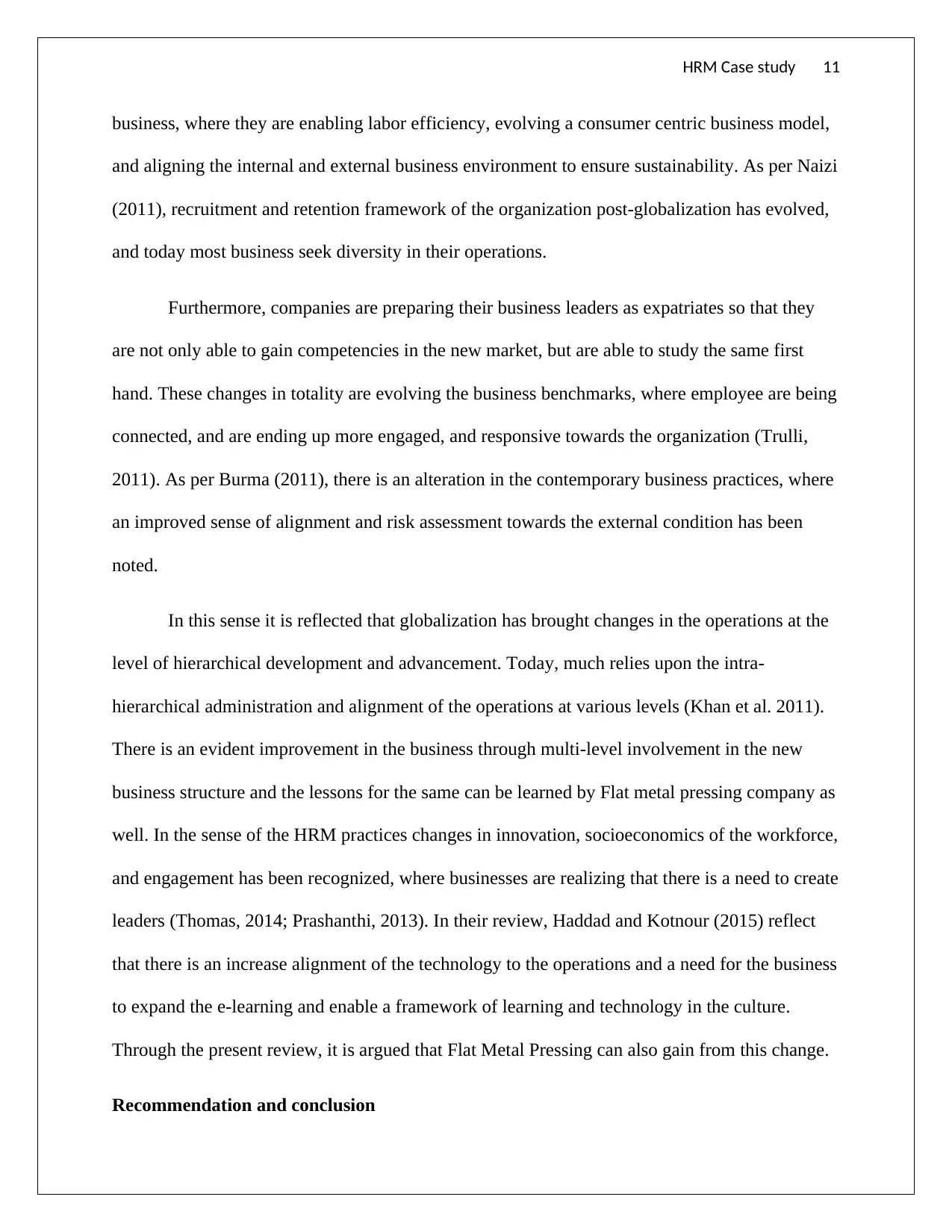
HRM Case study 11
business, where they are enabling labor efficiency, evolving a consumer centric business model,
and aligning the internal and external business environment to ensure sustainability. As per Naizi
(2011), recruitment and retention framework of the organization post-globalization has evolved,
and today most business seek diversity in their operations.
Furthermore, companies are preparing their business leaders as expatriates so that they
are not only able to gain competencies in the new market, but are able to study the same first
hand. These changes in totality are evolving the business benchmarks, where employee are being
connected, and are ending up more engaged, and responsive towards the organization (Trulli,
2011). As per Burma (2011), there is an alteration in the contemporary business practices, where
an improved sense of alignment and risk assessment towards the external condition has been
noted.
In this sense it is reflected that globalization has brought changes in the operations at the
level of hierarchical development and advancement. Today, much relies upon the intra-
hierarchical administration and alignment of the operations at various levels (Khan et al. 2011).
There is an evident improvement in the business through multi-level involvement in the new
business structure and the lessons for the same can be learned by Flat metal pressing company as
well. In the sense of the HRM practices changes in innovation, socioeconomics of the workforce,
and engagement has been recognized, where businesses are realizing that there is a need to create
leaders (Thomas, 2014; Prashanthi, 2013). In their review, Haddad and Kotnour (2015) reflect
that there is an increase alignment of the technology to the operations and a need for the business
to expand the e-learning and enable a framework of learning and technology in the culture.
Through the present review, it is argued that Flat Metal Pressing can also gain from this change.
Recommendation and conclusion
business, where they are enabling labor efficiency, evolving a consumer centric business model,
and aligning the internal and external business environment to ensure sustainability. As per Naizi
(2011), recruitment and retention framework of the organization post-globalization has evolved,
and today most business seek diversity in their operations.
Furthermore, companies are preparing their business leaders as expatriates so that they
are not only able to gain competencies in the new market, but are able to study the same first
hand. These changes in totality are evolving the business benchmarks, where employee are being
connected, and are ending up more engaged, and responsive towards the organization (Trulli,
2011). As per Burma (2011), there is an alteration in the contemporary business practices, where
an improved sense of alignment and risk assessment towards the external condition has been
noted.
In this sense it is reflected that globalization has brought changes in the operations at the
level of hierarchical development and advancement. Today, much relies upon the intra-
hierarchical administration and alignment of the operations at various levels (Khan et al. 2011).
There is an evident improvement in the business through multi-level involvement in the new
business structure and the lessons for the same can be learned by Flat metal pressing company as
well. In the sense of the HRM practices changes in innovation, socioeconomics of the workforce,
and engagement has been recognized, where businesses are realizing that there is a need to create
leaders (Thomas, 2014; Prashanthi, 2013). In their review, Haddad and Kotnour (2015) reflect
that there is an increase alignment of the technology to the operations and a need for the business
to expand the e-learning and enable a framework of learning and technology in the culture.
Through the present review, it is argued that Flat Metal Pressing can also gain from this change.
Recommendation and conclusion
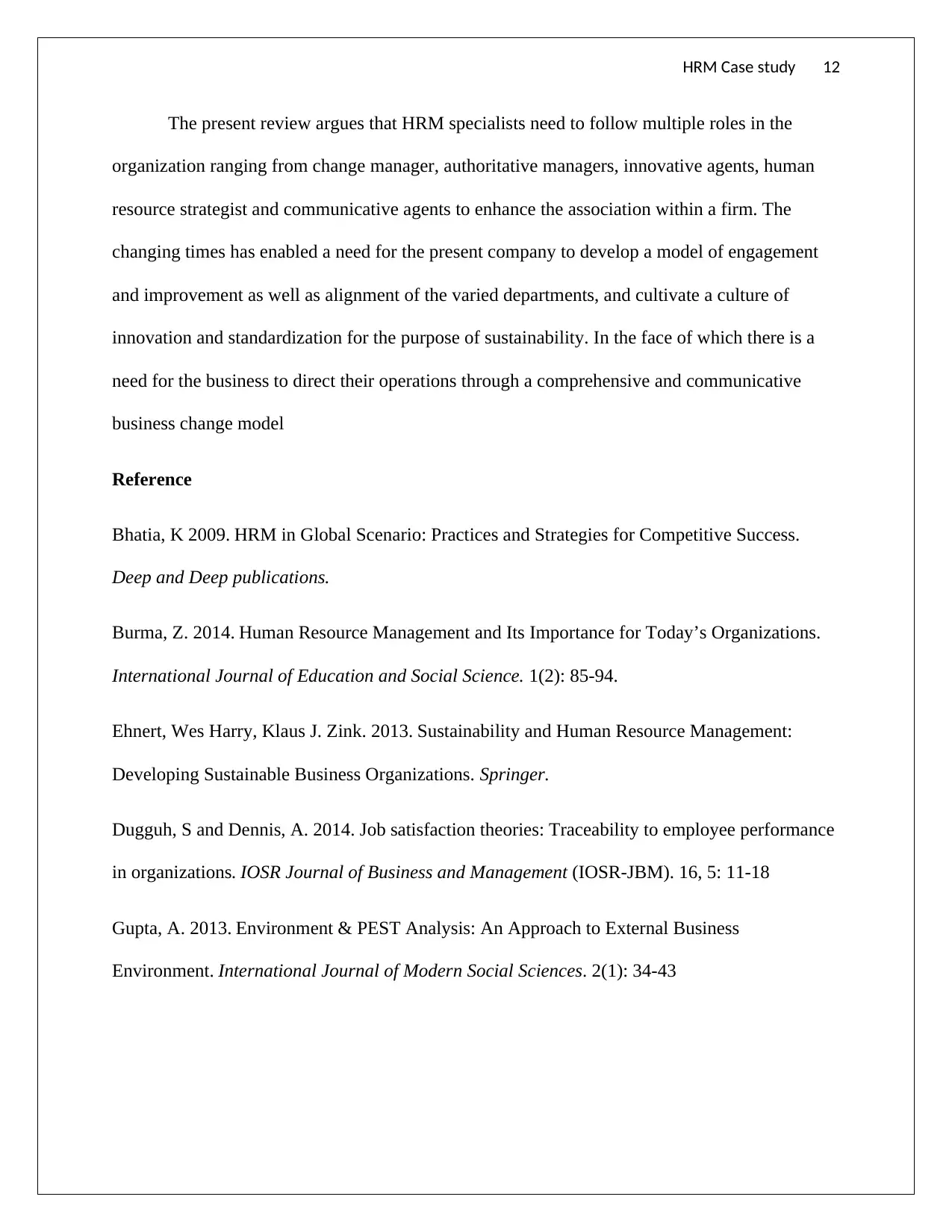
HRM Case study 12
The present review argues that HRM specialists need to follow multiple roles in the
organization ranging from change manager, authoritative managers, innovative agents, human
resource strategist and communicative agents to enhance the association within a firm. The
changing times has enabled a need for the present company to develop a model of engagement
and improvement as well as alignment of the varied departments, and cultivate a culture of
innovation and standardization for the purpose of sustainability. In the face of which there is a
need for the business to direct their operations through a comprehensive and communicative
business change model
Reference
Bhatia, K 2009. HRM in Global Scenario: Practices and Strategies for Competitive Success.
Deep and Deep publications.
Burma, Z. 2014. Human Resource Management and Its Importance for Today’s Organizations.
International Journal of Education and Social Science. 1(2): 85-94.
Ehnert, Wes Harry, Klaus J. Zink. 2013. Sustainability and Human Resource Management:
Developing Sustainable Business Organizations. Springer.
Dugguh, S and Dennis, A. 2014. Job satisfaction theories: Traceability to employee performance
in organizations. IOSR Journal of Business and Management (IOSR-JBM). 16, 5: 11-18
Gupta, A. 2013. Environment & PEST Analysis: An Approach to External Business
Environment. International Journal of Modern Social Sciences. 2(1): 34-43
The present review argues that HRM specialists need to follow multiple roles in the
organization ranging from change manager, authoritative managers, innovative agents, human
resource strategist and communicative agents to enhance the association within a firm. The
changing times has enabled a need for the present company to develop a model of engagement
and improvement as well as alignment of the varied departments, and cultivate a culture of
innovation and standardization for the purpose of sustainability. In the face of which there is a
need for the business to direct their operations through a comprehensive and communicative
business change model
Reference
Bhatia, K 2009. HRM in Global Scenario: Practices and Strategies for Competitive Success.
Deep and Deep publications.
Burma, Z. 2014. Human Resource Management and Its Importance for Today’s Organizations.
International Journal of Education and Social Science. 1(2): 85-94.
Ehnert, Wes Harry, Klaus J. Zink. 2013. Sustainability and Human Resource Management:
Developing Sustainable Business Organizations. Springer.
Dugguh, S and Dennis, A. 2014. Job satisfaction theories: Traceability to employee performance
in organizations. IOSR Journal of Business and Management (IOSR-JBM). 16, 5: 11-18
Gupta, A. 2013. Environment & PEST Analysis: An Approach to External Business
Environment. International Journal of Modern Social Sciences. 2(1): 34-43
⊘ This is a preview!⊘
Do you want full access?
Subscribe today to unlock all pages.

Trusted by 1+ million students worldwide
1 out of 14
Related Documents
Your All-in-One AI-Powered Toolkit for Academic Success.
+13062052269
info@desklib.com
Available 24*7 on WhatsApp / Email
![[object Object]](/_next/static/media/star-bottom.7253800d.svg)
Unlock your academic potential
Copyright © 2020–2025 A2Z Services. All Rights Reserved. Developed and managed by ZUCOL.





